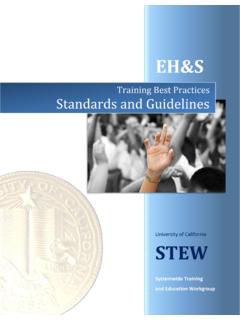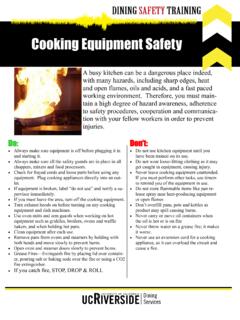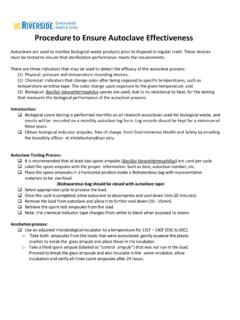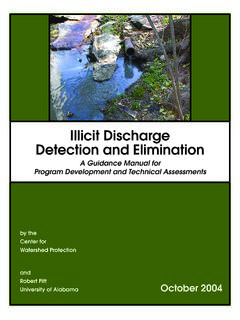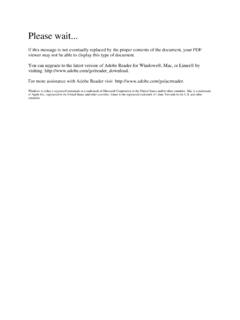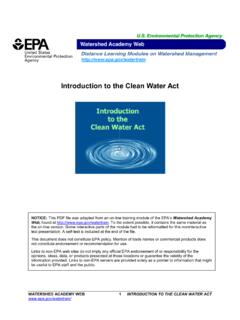Transcription of Drainage System Maintenance - Environmental Health & …
1 Drainage System Maintenance SC-74 January 2003 California Stormwater BMP Handbook 1 of 9 Municipal Description As a consequence of its function, the stormwater conveyance System collects and transports urban runoff that may contain certain pollutants. Maintaining catch basins, stormwater inlets, and other stormwater conveyance structures on a regular basis will remove pollutants, prevent clogging of the downstream conveyance System , restore catch basins sediment trapping capacity, and ensure the System functions properly hydraulically to avoid flooding.
2 Approach Suggested Protocols Catch Basins/Inlet Structures Municipal staff should regularly inspect facilities to ensure the following: - Immediate repair of any deterioration threatening structural integrity. - Cleaning before the sump is 40% full. Catch basins should be cleaned as frequently as needed to meet this standard. - Stenciling of catch basins and inlets (see SC-75 Waste Handling and Disposal). Clean catch basins, storm drain inlets, and other conveyance structures in high pollutant load areas just before the wet season to remove sediments and debris accumulated during the summer.
3 Objectives Contain Educate Reduce/Minimize Targeted Constituents Sediment ; Nutrients ; Trash ; Metals ; Bacteria ; Oil and Grease ; Organics ; Oxygen Demanding ; Photo Credit: Geoff Brosseau SC-74 Drainage System Maintenance 2 of 9 California Stormwater BMP Handbook January 2003 Municipal Conduct inspections more frequently during the wet season for problem areas where sediment or trash accumulates more often.
4 Clean and repair as needed. Keep accurate logs of the number of catch basins cleaned. Record the amount of waste collected. Store wastes collected from cleaning activities of the Drainage System in appropriate containers or temporary storage sites in a manner that prevents discharge to the storm drain. Dewater the wastes with outflow into the sanitary sewer if permitted. Water should be treated with an appropriate filtering device prior to discharge to the sanitary sewer. If discharge to the sanitary sewer is not allowed, water should be pumped or vacuumed to a tank and properly disposed of.
5 Do not dewater near a storm drain or stream. Except for small communities with relatively few catch basins that may be cleaned manually, most municipalities will require mechanical cleaners such as eductors, vacuums, or bucket loaders. Storm Drain Conveyance System Locate reaches of storm drain with deposit problems and develop a flushing schedule that keeps the pipe clear of excessive buildup. Collect flushed effluent and pump to the sanitary sewer for treatment. Pump Stations Clean all storm drain pump stations prior to the wet season to remove silt and trash. Do not allow discharge from cleaning a storm drain pump station or other facility to reach the storm drain System .
6 Conduct quarterly routine Maintenance at each pump station. Inspect, clean, and repair as necessary all outlet structures prior to the wet season. Sample collected sediments to determine if landfill disposal is possible, or illegal discharges in the watershed are occurring. Open Channel Consider modification of storm channel characteristics to improve channel hydraulics, to increase pollutant removals, and to enhance channel/creek aesthetic and habitat value. Conduct channel modification/improvement in accordance with existing laws. Any person, government agency, or public utility proposing an activity that will change the natural (emphasis added) state of any river, stream, or lake in California, must enter into a steam or Lake Alteration Agreement with the Department of Fish and Game.
7 The developer-applicant should also contact local governments (city, county, special districts), other state agencies Drainage System Maintenance SC-74 January 2003 California Stormwater BMP Handbook 3 of 9 Municipal (SWRCB, RWQCB, Department of Forestry, Department of Water Resources), and Federal Corps of Engineers and USFWS Illicit Connections and Discharges During routine Maintenance of conveyance System and Drainage structures field staff should look for evidence of illegal discharges or illicit connections: - Is there evidence of spills such as paints, discoloring, etc.
8 - Are there any odors associated with the Drainage System - Record locations of apparent illegal discharges/illicit connections - Track flows back to potential dischargers and conduct aboveground inspections. This can be done through visual inspection of up gradient manholes or alternate techniques including zinc chloride smoke testing, fluorometric dye testing, physical inspection testing, or television camera inspection. - Once the origin of flow is established, require illicit discharger to eliminate the discharge. Stencil storm drains, where applicable, to prevent illegal disposal of pollutants.
9 Storm drain inlets should have messages such as Dump No Waste Drains to Stream stenciled next to them to warn against ignorant or intentional dumping of pollutants into the storm Drainage System . Refer to fact sheet SC-10 Non-Stormwater Discharges. Illegal Dumping Regularly inspect and clean up hot spots and other storm Drainage areas where illegal dumping and disposal occurs. Establish a System for tracking incidents. The System should be designed to identify the following: - Illegal dumping hot spots - Types and quantities (in some cases) of wastes - Patterns in time of occurrence (time of day/night, month, or year) - Mode of dumping (abandoned containers, midnight dumping from moving vehicles, direct dumping of materials, accidents/spills) - Responsible parties Post No Dumping signs in problem areas with a phone number for reporting dumping and disposal.
10 Signs should also indicate fines and penalties for illegal dumping. Refer to fact sheet SC-10 Non-Stormwater Discharges. SC-74 Drainage System Maintenance 4 of 9 California Stormwater BMP Handbook January 2003 Municipal The State Department of Fish and Game has a hotline for reporting violations called Cal TIP (1-800-952-5400).
